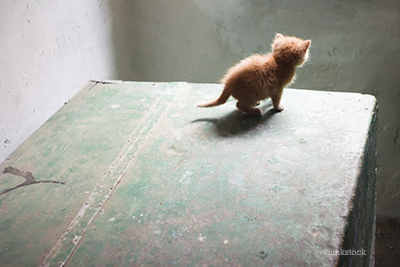
Dr. Phil Zeltzman is a mobile, board-certified surgeon in Allentown, PA. Find him online at www.DrPhilZeltzman.com. He is the co-author of “Walk a Hound, Lose a Pound” (www.WalkaHound.com).
Katie Kegerise, a Certified Veterinary Technician in Reading, PA, contributed to this article.
Part of our love for kittens is explained by their gigantic blue eyes, their playfulness and their innocence. Unfortunately, it is precisely because they are playful and innocent that they can get is serious trouble if you are not aware of the following 10 classic dangers.
1. Attack of the Recliner
Kittens love to explore and they sometimes hide in small dark places. However, when they hide inside your favorite recliner, you can imagine the consequences when sharp metal parts start moving around.
2. Wrong Place, Wrong Time
Little kitty feet and tails are very delicate. They sometimes find themselves in the wrong place at the wrong time if you're not careful. A misplaced step, a tilt of your rocking chair, or a quickly closed door can result in major injuries.
3. Housemate Woes
Unfortunately, it's impossible to tell how your current critter(s) will react to a newcomer. Kittens can face harm from your dog or your cat if their presence is suddenly unwelcome. Risks include not allowing the youngster to eat, fights and bites.
4. Tight Fit
For little fur-balls, getting into a small space is sometimes a lot easier than getting out. Radiators, couches and other furniture, as well as very tiny openings present opportunities for your little one to get stuck. Rumor has it that they could even get stuck in the opening of the disposal in your kitchen sink if you leave tasty food in there (think fishy leftovers). It can be very tricky to get them back out.
5. Tall Places
Kittens come preprogrammed with the ability to climb… but not the knowledge of how to get back down. Just ask your friendly fireman if they’ve ever had to rescue a cat from the top of a tree. Curtains, book shelves, TV entertainment centers, china cabinets, refrigerators all seem to attract curious kittens. Tall perches are a fun place for kitties to get a good view of their environment, but pose a serious threat when it comes to jumping down.
6. Outdoor Predators
Even if you live in a suburban or city setting, predators such as foxes, coyotes, hawks, eagles and snakes can pose a threat to your new furry friend. Keeping them indoors is the best way to keep them from becoming a snack for wild animals.
7. Rough Handling
Young children don’t realize how fragile kittens (and puppies) are. It is important to teach them to be very gentle with pets in general and kittens in particular, or to only allow them to handle them under adult supervision.
8. Household Plants
Your beautiful blooms or luscious plants may actually be toxic to your new kitten. For a thorough list of dangerous household plants, consult Dr. Justine Lee's blog on poisonous flowers and plants.
9. Appliance Dangers
Some curious kittens love to climb into appliances such as dishwashers, stoves, refrigerators, washing machines and mostly dryers. However, when the door closes and a wash or dry cycle starts, your kitty could face serious harm or even death.
10. Linear Foreign Bodies
A kitten playing with a ball of yarn is the definition of cute, but when that kitten decides to make that yarn a snack, emergency surgery may be the only way to remove it. The same applies to anything that looks like a “linear foreign body,” including string, rope, floss, hair ties and ribbon. Keep these items away where they can't be accessed by your new kitty. It is acceptable to let a kitten, or an adult cat for that matter, play with a string, but always under close adult supervision.
Being aware of these top 10 dangers will hopefully keep you away from the ER and should allow you to enjoy your new kitten even more.
If you have any questions or concerns, you should always visit or call your veterinarian – they are your best resource to ensure the health and well-being of your pets.
